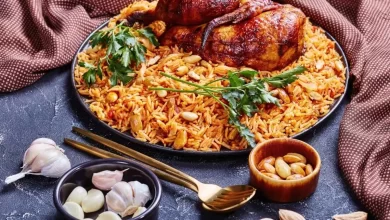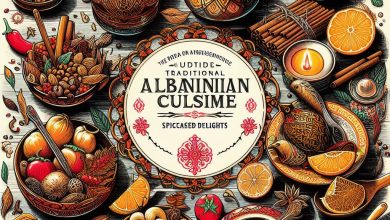How healthy are traditional dishes in Albania? Is Albanian food spicy?
dishes in Albania
How healthy are traditional dishes in Albania?
The nutritional value of traditional Albanian recipes can vary greatly because they use a variety of ingredients and cooking techniques. The choice of ingredients, cooking methods, and portion sizes all have an impact on how healthy a dish is. Here are some factors to take into account when determining how healthy traditional Albanian foods are:
Nutrient-Rich Ingredients: Fresh vegetables, lean meats (particularly lamb and fish), whole grains, and dairy items like yogurt and cheese are all included in many traditional Albanian meals. These components supply vital proteins, minerals, and vitamins.
Albanian food has a Mediterranean flavor thanks to the region’s widely regarded as healthy eating habits. Olive oil, fresh produce, legumes, and seafood are staples of Mediterranean diets, all of which have been linked to improved heart health.
Meals that are well-balanced in terms of carbohydrates, protein, and fats are a common feature of traditional Albanian meals. This may support a diet that is well-rounded.
Use of Herbs and Spices: Albanian food frequently uses herbs and spices to add taste rather than a lot of salt or harmful sauces. Mint, oregano, and garlic are among the often utilized herbs.
Fresh and Homemade: Many traditional foods are cooked from scratch with high-quality ingredients. Meals created from scratch often offer more control over ingredient quality and portion quantities.
Regarding the healthfulness of Albanian cuisine, there are a few other things to take into account:
Caloric Density: Traditional Albanian dishes with pastry or meat cooked in hearty sauces may be high in calories. To prevent consuming too many calories, it’s crucial to pay attention to portion sizes.
Cooking Methods: Due to the extra fat content, fried and deep-fried foods can be less healthful. Making the choice of grilled, roasted, or baked foods can be healthier.
Dairy Products: Although yogurt and cheese are frequently used in Albanian cooking, if these products are utilized in excess, some traditional meals may contain a lot of saturated fat.
Bread and pastries should be consumed in moderation with other food groups to prevent consuming too many carbohydrates. In Albania, bread and pastries are frequently served with meals.
Desserts: Baklava and kadaif are examples of traditional sweets from Albania, both of which are high in calories. You should only consume these in moderation.
In conclusion, a number of variables, including as the materials used, the methods of preparation, and the serving sizes, affect how healthy traditional Albanian recipes are. When eaten mindfully, with an emphasis on fresh, whole ingredients and moderation in the consumption of calorie-dense foods, many Albanian recipes can be a component of a healthy and balanced diet.

Is Albanian food spicy?
The majority of the time, Albanian cuisine is not extremely spicy. Although there are many different aromatic herbs and spices used in Albanian cooking, the natural flavors of fresh ingredients and the usage of herbs like mint, oregano, and garlic are often preferred to highly spicy food.
The heat level in traditional Albanian recipes is normally very moderate in comparison to cuisines recognized for their spiciness, such as Indian or Mexican food. Some traditional Albanian dishes may contain mild chili peppers or red pepper flakes for extra taste.
The degree of spiciness in individual dishes or regional variations of Albanian cuisine may vary depending on the individual’s spice preferences, although this does not make the food in general particularly spicy. You shouldn’t experience overpowering heat when eating numerous Albanian foods if you have a low tolerance for spice.
Special Dishes:
The particular and distinctive dishes that make up Albanian cuisine highlight the nation’s rich culinary heritage. Here are some unique cuisines and dishes you may come across in Albanian cuisine:
Tav Elbasani: This meal is named after the city of Elbasan and is made up of layers of rice, yogurt, and sliced lamb that are baked to perfection. It resembles Tav Kosi but is unique to the Elbasan region.
Flija: Cooked over an open flame, this traditional Albanian meal is constructed of several layers of extremely thin pancakes. It is frequently served with a yogurt or honey drizzle.
Petulla: These are deep-fried fritters or doughnuts, which are frequently eaten for dessert or as a snack. They can either be served plain or stuffed with cheese, honey, or jam.
Speca me Gjize: This dish consists of roasted peppers that have been filled with a cottage cheese, egg, and herb mixture. It is a tasty and filling appetizer.
Tav Prizreni: This Prizren-originating meal is made up of layers of roasted eggplants, lamb or other minced meat, tomatoes, and peppers.
Qifqi: Qifqi are deep-fried rice and tomato balls that have been spiced up with a variety of herbs and seasonings. They are a well-liked entrée or side dish.
Kokoreç: A special delicacy made from grilled lamb or goat intestines that have been wrapped around seasoned offal (organs). Sandwiches with veggies and seasonings are frequently served with it.
Pispili: Pispili are cornmeal pancakes that can be topped with a variety of ingredients, including cheese, yogurt, and honey. They are especially well-liked in the
These are only a few of the unique cuisines and dishes available in Albanian cuisine. Discovering the local food is a fun way to experience the many culinary traditions of Albania, as each region has its own distinctive delicacies.



